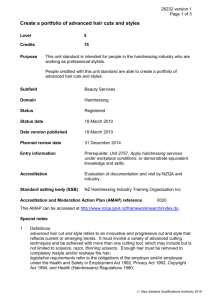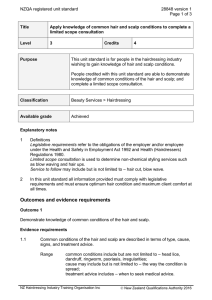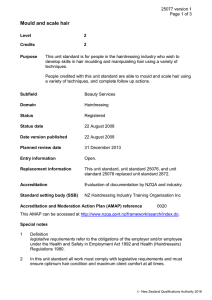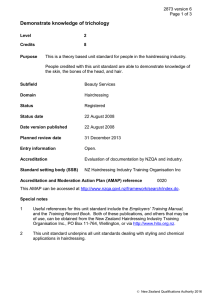NZQA registered unit standard 2885 version 5 Page 1 of 3
advertisement
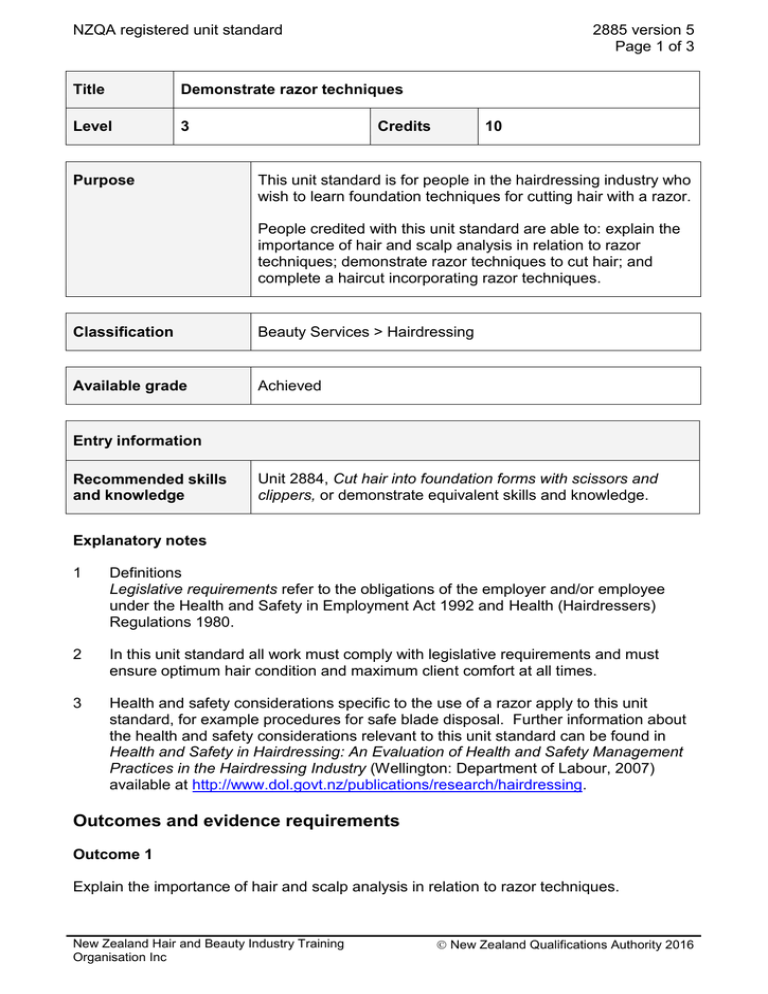
NZQA registered unit standard 2885 version 5 Page 1 of 3 Title Demonstrate razor techniques Level 3 Purpose Credits 10 This unit standard is for people in the hairdressing industry who wish to learn foundation techniques for cutting hair with a razor. People credited with this unit standard are able to: explain the importance of hair and scalp analysis in relation to razor techniques; demonstrate razor techniques to cut hair; and complete a haircut incorporating razor techniques. Classification Beauty Services > Hairdressing Available grade Achieved Entry information Recommended skills and knowledge Unit 2884, Cut hair into foundation forms with scissors and clippers, or demonstrate equivalent skills and knowledge. Explanatory notes 1 Definitions Legislative requirements refer to the obligations of the employer and/or employee under the Health and Safety in Employment Act 1992 and Health (Hairdressers) Regulations 1980. 2 In this unit standard all work must comply with legislative requirements and must ensure optimum hair condition and maximum client comfort at all times. 3 Health and safety considerations specific to the use of a razor apply to this unit standard, for example procedures for safe blade disposal. Further information about the health and safety considerations relevant to this unit standard can be found in Health and Safety in Hairdressing: An Evaluation of Health and Safety Management Practices in the Hairdressing Industry (Wellington: Department of Labour, 2007) available at http://www.dol.govt.nz/publications/research/hairdressing. Outcomes and evidence requirements Outcome 1 Explain the importance of hair and scalp analysis in relation to razor techniques. New Zealand Hair and Beauty Industry Training Organisation Inc New Zealand Qualifications Authority 2016 NZQA registered unit standard 2885 version 5 Page 2 of 3 Evidence requirements 1.1 Hair and scalp analysis is explained in terms of the choice of razor technique. Range 1.2 includes but is not limited to – porosity, elasticity, texture, density, length, growth patterns. Other factors that could be identified through a hair and scalp analysis are explained in terms of how they affect the choice of razor technique. Range may include but is not limited to – scalp conditions. Outcome 2 Demonstrate razor techniques to cut hair. Range may include but is not limited to – long taper, short taper, blunt cut, texturising; evidence is required for six techniques; demonstration may take place using a mannequin. Evidence requirements 2.1 Assembled tools match requirements for each razor technique. 2.2 Razor techniques achieve desired cutting outcome. Outcome 3 Complete a haircut incorporating razor techniques. Range two razor techniques must be incorporated in to the haircut; at least 75% of the haircut must be achieved using a razor, scissors may be used for up to 25% of the haircut. Evidence requirements 3.1 Consultation with client confirms desired outcome. Range 3.2 consultation must include a hair and scalp analysis. Completed hair cut matches consultation outcome. Range systematically cut. 3.3 Haircut is completed within 30 minutes. 3.4 Record card is filled out in accordance with workplace requirements. Range 3.5 client details, completed service, advice provided. Tools and equipment are sanitised in accordance with workplace requirements. New Zealand Hair and Beauty Industry Training Organisation Inc New Zealand Qualifications Authority 2016 NZQA registered unit standard 3.6 2885 version 5 Page 3 of 3 The work area is cleaned and tidied in accordance with workplace requirements. work area – shampoo area, styling station. Range Planned review date 31 December 2019 Status information and last date for assessment for superseded versions Process Version Date Last Date for Assessment Registration 1 8 February 1995 31 December 2016 Review 2 19 December 1997 31 December 2016 Review 3 27 January 2003 31 December 2016 Review 4 22 August 2008 31 December 2016 Review 5 19 March 2015 N/A Consent and Moderation Requirements (CMR) reference 0020 This CMR can be accessed at http://www.nzqa.govt.nz/framework/search/index.do. Please note Providers must be granted consent to assess against standards (accredited) by NZQA, before they can report credits from assessment against unit standards or deliver courses of study leading to that assessment. Industry Training Organisations must be granted consent to assess against standards by NZQA before they can register credits from assessment against unit standards. Providers and Industry Training Organisations, which have been granted consent and which are assessing against unit standards must engage with the moderation system that applies to those standards. Requirements for consent to assess and an outline of the moderation system that applies to this standard are outlined in the Consent and Moderation Requirements (CMRs). The CMR also includes useful information about special requirements for organisations wishing to develop education and training programmes, such as minimum qualifications for tutors and assessors, and special resource requirements. Comments on this unit standard Please contact New Zealand Hair and Beauty Industry Training Organisation Inc at enquiries@hito.org.nz if you wish to suggest changes to the content of this unit standard. New Zealand Hair and Beauty Industry Training Organisation Inc New Zealand Qualifications Authority 2016
